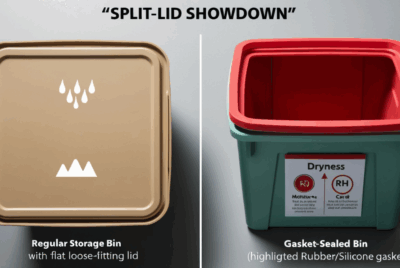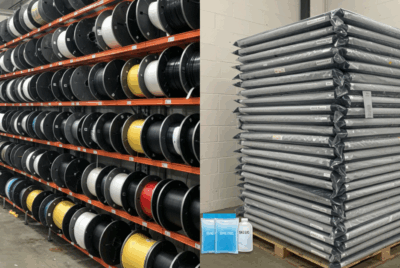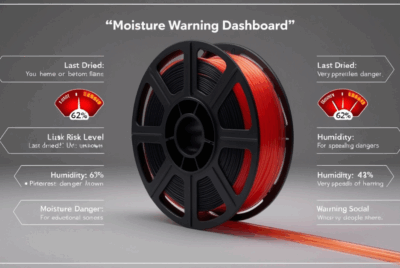What are the best drying methods?
There are several effective methods for drying 3D filament to remove moisture and ensure high-quality prints. Below are the best drying methods, each suited for different needs and filament types:
1. Filament Dryer (Dedicated Dryer)
- Method: A filament dryer is a device specifically designed to remove moisture from filament. These dryers gently heat the filament and circulate air around it, ensuring it dries evenly.
- How to Do It:
- Place the filament spool in the dryer and set the appropriate temperature for the filament type (typically around 45-50°C for PLA).
- The dryer will run for several hours, removing moisture efficiently.
- Benefits:
- Easy to use, with precise temperature control.
- Can dry multiple spools at once.
- Ideal for various filament types (PLA, ABS, Nylon, etc.).
- Examples: Sunlu Filament Dryer, PrintDry Filament Dryer, 3D Fuel Filament Drying Oven.
2. Oven Drying
- Method: An oven is a common household item that can be used to dry filament. The key is to use low heat to avoid damaging the filament.
- How to Do It:
- Preheat the oven to a low temperature (typically 45-50°C for PLA).|
- Place the filament spool on a baking tray or heat-safe container. You may want to cover the spool loosely with aluminum foil to prevent direct heat exposure.
- Bake the filament for about 4-6 hours (depending on the filament type and moisture level).
- Benefits:
- Accessible and inexpensive.
- Works well for drying filament that needs quick moisture removal.
- Caution: Keep the oven door slightly ajar to allow moisture to escape. Avoid temperatures above 50°C to prevent damage to the filament.
3. Food Dehydrator
- Method: A food dehydrator uses gentle heat and airflow to remove moisture, making it a great tool for drying filament without risking overheating.
- How to Do It:
- Set the dehydrator to a low temperature (usually around 45-50°C).
- Place the filament spool inside, ensuring it doesn’t touch the dehydrator’s sides.
- Dry the filament for several hours (usually 4-8 hours).
- Benefits:
- Even heat distribution and efficient drying.
- Great for drying multiple spools at once.
- Designed for moisture removal, so it’s perfect for filament.
- Examples: Excalibur Food Dehydrator.
4. Desiccant Drying
- Method: Desiccants, such as silica gel or clay desiccants, can be used to absorb moisture from filament over time.
- How to Do It:
- Place the filament spool in an airtight container or vacuum-sealed bag with desiccant packets.
- Leave the spool for several days (depending on moisture levels) in the container.
- Benefits:
- Low maintenance and cost-effective.
- Good for long-term storage and preventing moisture absorption.
- Caution: This method is slow and works best for preventive moisture control rather than emergency drying.
5. Hairdryer (For Quick Drying)
- Method: A hairdryer can be used as a quick method to dry filament if you’re in a pinch.
- How to Do It:
- Set the hairdryer to a low heat setting.
- Hold it several inches away from the filament spool, moving it back and forth to avoid overheating any specific area.
- Dry for 10-20 minutes, depending on the moisture level.
- Benefits:
- Quick and portable.
- Works well for small filament amounts or emergencies.
- Caution: Avoid using too much heat or focusing the air in one spot for too long, as this can cause the filament to soften or warp.
6. Vacuum-Sealed Bags
- Method: While not an active drying method, vacuum-sealed bags with desiccants can help prevent filament from absorbing moisture by creating a moisture-free environment.
- How to Do It:
- Place the filament spool in a vacuum-seal bag with a desiccant packet.
- Use a vacuum sealer to remove the air from the bag and store the filament in a cool, dry place.
- Benefits:
- Prevents moisture from re-entering the filament during storage.
- Provides a simple, passive drying solution.
7. Dry Box with Built-In Heating and Dehumidification
- Method: Some filament storage boxes are equipped with built-in heating and dehumidification systems that actively control the environment to keep filament dry.
- How to Do It:
- Place the filament spool in the dry box and set the appropriate drying conditions (temperature and humidity).
- Let the box run until the filament is dried.
- Benefits:
- Provides optimal storage and drying in one system.
- Ideal for long-term storage and frequent filament use.
- Examples: Eibos Dry Box, PrintDry Storage Box.
Choosing the Best Drying Method
The best method depends on the amount of filament, the level of moisture, and how quickly you need the filament to be dried. For quick drying, a filament dryer or oven works well. For longer-term moisture prevention, vacuum-sealing with desiccants is effective.
Each drying method has its advantages, so choose one that suits your needs based on convenience, time, and filament volume.




